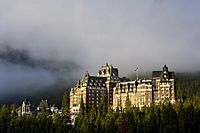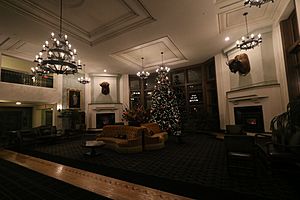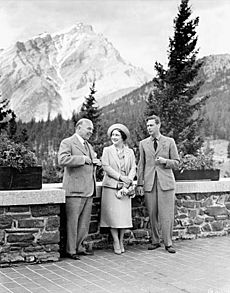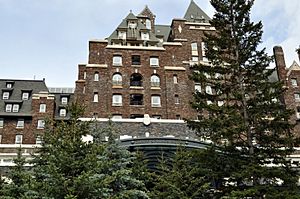Banff Springs Hotel facts for kids
| Fairmont Banff Springs | |
Quick facts for kids  View of the Banff Springs Hotel |
|
| Hotel facts and statistics | |
|---|---|
| Location | Banff, Alberta, Canada |
| Coordinates | 51°09′52″N 115°33′43″W / 51.16444°N 115.56194°W |
| Address | |
| Architect | Bruce Price (original) Walter Painter (tower) John Orrock (main block) |
| Management | Fairmont Hotels and Resorts |
| Owner | Oxford Properties |
| No. of restaurants | 12 |
| No. of rooms | 764 |
| No. of floors | 15 |
The Fairmont Banff Springs is a famous old hotel in Banff, Alberta, Canada. Many people still call it the Banff Springs Hotel. It is located inside Banff National Park, which is a special protected area. The hotel sits in a beautiful valley, looking out at Mount Rundle and the amazing Rocky Mountains. It is about 1,414 metres (4,639 ft) above sea level.
This grand hotel first opened its doors in 1888. It was built by the Canadian Pacific Railway as one of Canada's first big railway hotels. Over the years, the hotel has grown and changed a lot. The first building was designed by Bruce Price. Sadly, a fire destroyed the original wooden hotel in 1926. But a new, stronger building was finished in 1928. Because of its important history and unique design, the hotel was named a National Historic Site of Canada in 1988. Today, the Fairmont Hotels and Resorts company manages the hotel.
Contents
Where is the Hotel?
The Banff Springs Hotel is at 405 Spray Avenue in the southern part of Banff. Banff is a popular resort town located within Banff National Park. The hotel is surrounded by roads and natural waterways. To the north, you'll find Bow River Avenue and Rundle River Avenue. Spray Avenue is to the west. On the east side, the hotel is next to the Spray River. This river flows into the Bow River, which is just north of the hotel. The hotel is built close to where these two rivers meet.
The town of Banff is nestled in the Rocky Mountains, about 1,414 metres (4,639 ft) above sea level. The town itself is built around Tunnel Mountain. From the hotel, you can see across the valley to Mount Rundle. Other mountains nearby include Cascade Mountain, Mount Norquay, Stoney Squaw Mountain, and Sulphur Mountain. Since it's in a national park, the hotel is close to many natural sights. Just north of the hotel on the Bow River are the beautiful Bow Falls. To the south, you can visit the Banff Upper Hot Springs, which are warm natural pools.
Hotel Design and Look
Building Style
The Banff Springs Hotel is one of Canada's grand railway hotels, built by the Canadian Pacific Railway. The hotel today has two main parts: an eleven-story tower and the main block. The tower, also called the center wing, was designed by Walter S. Painter. Its construction started in 1911 and finished in 1914. The main block of the hotel was built between 1927 and 1928. It replaced the first wooden hotel that burned down. The original building was a five-story wooden structure with space for 280 guests. It was designed by Bruce Price. On June 24, 1988, the hotel buildings were officially named a National Historic Site of Canada.
After the original wooden building burned down in 1926, John W. Orrock, an engineer for Canadian Pacific Railway, designed its replacement. This new building, the main block, included the north and south wings. Like the tower built in 1911, this new part has a strong steel frame covered with Rundle limestone. Orrock used ideas from the original wooden building's style. This means the main block also looks like the chateaus (castles) found in the Loire Valley in France. So, it has large stone walls, steep copper roofs, and decorative dormers and gables.
The original wooden hotel, which inspired the design of the current north and south wings, combined ideas from Scottish baronial architecture and French chateaus. This mix of styles led to the unique Châteauesque style, which was used for many grand railway hotels in Canada. Châteauesque features you can see on the Banff Springs Hotel include its steep roofs, pointed dormers, and round towers at the corners. However, unlike some later Châteauesque hotels, the Banff Springs Hotel also has elements from the Arts and Crafts movement. These include rounded gables and rough stone work throughout the building.
The center wing tower is a large limestone building. It was mostly influenced by Scottish baronial architecture. This part of the hotel was planned as an extension to the first wooden building. Unlike the other parts of the hotel, the center tower has almost no French medieval design elements. Walter Painter's designs for the tower included rounded windows, flat dormers instead of pointed ones, and rounded arches instead of the pointed arches seen in French Gothic architecture. The central wing also had a Renaissance Revival styled arcade before its first floor lounge.

Inside the hotel, you'll find beautiful oak beams, oak panellings, animal carvings, fancy plasterwork on the ceilings, Terrazzo floors, and stained glass windows. Some of the materials used inside include fossil-filled carved Tyndall limestone from Garson, Manitoba, and Bedford lime flagstones on the floors of Mount Stephen Hall, a large event room.
What's Inside?
The Banff Springs Hotel has 757 guest rooms and suites. It also has many spaces for events like conferences, weddings, and parties. Some of these event rooms are the Alberta Dining Room, the Alhambra Dining Room, the Cascade Ballroom, Mount Stephen Hall, and the Riverview Walk. Because of its beautiful location, the hotel also has outdoor event areas, like a terrace garden.
You'll find many restaurants and places to eat inside the hotel. As of 2017, there were twelve restaurants. Some popular ones include 1888 Chop House, the Waldhaus, and the Rundle Bar. The "Castello" restaurant also offers afternoon tea. The hotel also has a market called Stock Food & Drinks that sells local food. Other fun things to do at the hotel include a bowling alley, five tennis courts, a swimming pool, and a 27-hole golf course. This golf course was designed by a famous golf course architect named Stanley Thompson. The hotel also added spa facilities in 1991, where you can relax and get treatments.
Hotel History
The first hotel building, built in 1888, was shaped like an "H". It had an eight-sided central hall and another wing that stretched towards the Bow River. The building was covered in shingles with stone details. There were tiered verandas (porches) at the end of each wing. This first building cost $250,000. A mistake was made during construction, and the building ended up facing away from the amazing mountain view! It had over 100 bedrooms around a five-story, eight-sided rotunda. In 1902, an addition was built, adding more than 200 rooms.
By 1906, there were plans to completely rebuild the Banff Springs Hotel. Walter Painter, the main architect for Canadian Pacific Railway, designed an eleven-story central tower made of concrete and stone. It was planned to have two wings on either side. This time, the building was correctly oriented to face the stunning mountain view. This "Painter Tower" was finished in 1914. It cost $2 million and had 300 guest rooms. For a while, it was the tallest building in Canada! Building new wings was delayed because of World War I, so the original Price wings continued to be used.
The hotel was named after William Davidson. He grew up in Moray, near Banff, Scotland. He was the first European settler in that part of Canada. The name of the Canadian city and national park comes from his Scottish hometown. Inside the hotel, halfway up the staircase closest to the Bow Falls, there is a painting of Davidson cutting trees on the Miramichi River long ago. This painting was done by the war artist Cyrus Cuneo (1879–1916), who created several paintings for the Canadian Pacific Railway.
More renovations were designed by architect J. W. Orrock. He continued the style started by Painter, making the Painter Tower much bigger, changing its roofline, and adding his own large additions. In 1926, while work was still going on, a fire destroyed the rest of the original building designed by Price. The two new wings were completed and opened in 1928.

The King of Canada, King George VI, and the future Queen Elizabeth visited the hotel during their royal tour in 1939. From 1942 to 1945, the hotel was closed to help with the war effort.
In 1968, the building was updated so it could stay open all year round, even in winter. The hotel had more renovations in the late 1900s, including one in 1971 and another to get ready for the 1988 Winter Olympics.
In 2001, Canadian Pacific Hotels, which was the hotel part of Canadian Pacific Railway, changed its name to Fairmont Hotels and Resorts. This happened after they bought an American company called Fairmont in 1999. The hotel's name was then changed to the Fairmont Banff Springs. In 2006, seven Fairmont hotels, including the Banff Springs, were sold to Oxford Properties. This company is owned by the Ontario Municipal Employees Retirement System. Even after the sale, Fairmont Hotels and Resorts still manages the hotel today.
See also
 In Spanish: Banff Springs Hotel para niños
In Spanish: Banff Springs Hotel para niños




